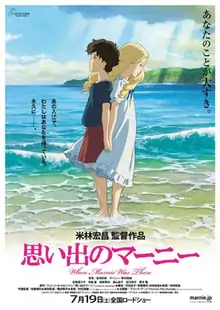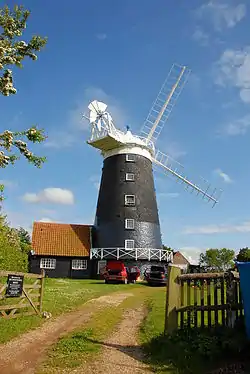When Marnie Was There
When Marnie Was There (Japanese: 思い出のマーニー, Hepburn: Omoide no Mānī, "Marnie of [My] Memories") is a 2014 Japanese anime drama film written and directed by Hiromasa Yonebayashi, produced by Studio Ghibli for Nippon Television Network, Dentsu, Hakuhodo DYMP, Walt Disney Japan, Mitsubishi, Toho and KDDI and distributed by Toho. It is based on Joan G. Robinson's 1967 novel of the same name.[2][3]
| When Marnie Was There | |
|---|---|
 Japanese theatrical release poster | |
| Japanese | 思い出のマーニー |
| Hepburn | Omoide no Mānī |
| Literally | Marnie of [my] Memories |
| Directed by | Hiromasa Yonebayashi |
| Produced by | Yoshiaki Nishimura |
| Screenplay by |
|
| Based on | When Marnie Was There by Joan G. Robinson |
| Starring | |
| Music by | Takatsugu Muramatsu |
| Cinematography | Atsushi Okuo |
| Edited by | Rie Matsubara |
Production company | |
| Distributed by | Toho |
Release date |
|
Running time | 103 minutes[1] |
| Country | Japan |
| Language | Japanese |
| Budget | ¥1.15 billion ($10.5 million) |
| Box office | ¥3.85 billion ($36 million) |
The film follows Anna Sasaki staying with her relatives in a town in Kushiro wetlands, Hokkaido. Anna comes across a nearby abandoned mansion, where she meets Marnie, a mysterious girl who asks her to promise to keep their secrets from everyone. As the summer progresses, Anna spends more time with Marnie, and eventually Anna learns the truth about her family and foster care.
It was the final film for Studio Ghibli, before it announced a short break after The Tale of the Princess Kaguya, and the retirement of Hayao Miyazaki a year before the film was released.[4] The film featured the final work for Studio Ghibli animator Makiko Futaki, who died in May 2016.[5] It was also the final film that Yonebayashi directed for Ghibli before he left and joined Studio Ponoc. The film received positive reviews from critics, praising its animation, music, vocal performances, and emotional story. It was released in theatres on 19 July 2014,[6] and on Blu-ray and DVD in Japan on 18 March 2015.[7] It was nominated for the Academy Award for Best Animated Feature at the 88th Academy Awards.



Plot
Anna Sasaki is an introverted 12-year-old girl with low self-esteem living in Sapporo with foster parents, Yoriko and her husband. One day, she suffers an asthma attack at school. The doctor insists that her asthma is being triggered by stress. At the doctor's recommendation to send Anna to a place where the air is clean, her parents decide to have her spend summer break with Yoriko's relatives, Setsu and Kiyomasa Oiwa, who live in a rural seaside town called Kissakibetsu, located between Kushiro and Nemuro.
Anna investigates an abandoned mansion across a salt marsh. She finds it familiar but gets trapped by the rising tide until she is found by Toichi, an old fisherman. Setsu tells her that the mansion used to be a vacation home for wealthy foreigners, but has been empty for a long time. Anna starts dreaming of a blonde girl in the mansion. On the night of the Tanabata festival, she meets the blonde girl, Marnie, at the mansion. The two agree to keep their meetings secret. Marnie asks about how Anna likes living with the Oiwas but disappears. Anna has visions of being back in the Oiwa house, implying that Anna is dreaming. Marnie invites Anna to a party at the mansion, where she sees Marnie dancing with a boy named Kazuhiko. Locals find Anna asleep outside, suggesting that the party may also have been a dream. The mansion also appears abandoned and dilapidated again.
Anna meets Hisako, an older woman who paints. Hisako comments that Anna's sketches look like a girl whom she knew when she was young. Not soon after a family is set to move into the mansion. At the mansion during the move-in, Anna meets a girl named Sayaka, who gives her Marnie's diary that had been hidden in a drawer. Anna meets Marnie again and admits to finding documents that show her foster parents are paid to take care of her. She makes the assumption that they only pretend to love her for the money, and says she can’t forgive her biological family for leaving her behind and dying. Marnie shares how her parents are always traveling abroad, and how she is always left behind with her rude nanny and two maids. The maids bully her and threaten to lock her in the silo near the mansion. Anna leads Marnie to the silo to confront the latter’s fear of it. Marnie conquers her fear and the pair fall asleep. Anna has a dream of Kazuhiko comforting Marnie. She wakes up, only to find Marnie gone, and is heartbroken.
Meanwhile, Sayaka finds the missing pages from Marnie's diary, which include passages about Kazuhiko and the silo. She and her brother search for Anna, only to find her unconscious with a high fever. They bring her back to the Oiwas, where Anna dreams about confronting Marnie, who tells Anna she is sorry for leaving her and that she cannot see Anna anymore.
When Anna recovers from her fever, Hisako reveals Marnie's story: Marnie married Kazuhiko and they had a daughter named Emily, who Marnie loved dearly due to years of loneliness and depression. Kazuhiko died from a sudden illness and Marnie committed herself to a sanatorium to cope with her loss. With no other family to care for her, Emily was sent to a boarding school at a young age. Marnie recovered but preteen Emily was resentful for her mother abandoning her. In her adulthood, Emily had a daughter herself, but she and her husband were killed in a car accident. Marnie raised her granddaughter, who was placed in foster care after her death.
At the end of the summer, Yoriko arrives to take Anna home and is delighted to see Anna having made new friends in Hisako, Toichi and Sayaka. She gives Anna a photograph of the mansion and says it belonged to Anna's grandmother. When Anna sees Marnie's name written on the back, she realizes that she is Emily's daughter, and Marnie's granddaughter. This revelation brings closure about her identity. Yoriko also tells Anna about the government payments, but reassures her that they have always loved her. For the first time Anna calls Yoriko her mother.
During the end credits, Anna says goodbye to her friends before seeing Marnie at the mansion window waving goodbye to her.
Production
The original novel by Joan G. Robinson had previously been cited by Hayao Miyazaki as one of his favorite children's novels.[8] Hiromasa Yonebayashi was assigned the project by Ghibli producer Toshio Suzuki, who asked him to change the setting of the story to Japan. Yonebayashi found the story moving, but he "thought it would be very difficult to visualize as a film," and initially turned down the role. His interest was later renewed, however, and he began to conceive of new elements for the story, such as Anna's characterization as an artist.[9] Although the setting was changed, the decision was made to retain Marnie's appearance as blonde and blue-eyed, though Miyazaki was opposed to this decision. He later criticized the usage of Marnie's character to promote the film, opining that it was "plain outdated and cheesy."[10]
Yonebayashi intended the film to be encouraging to children in Japan who felt lonely and isolated, and hoped that "when they see Marnie, maybe they could take a little step forward".[9] Key focus was placed upon highly detailed character movements and backgrounds, as well as depicting the details of Anna's experience in the environment.[11][12] The Marsh House that is central to the story was designed by Yohei Taneda, who Yonebayashi asked "to draw the Marsh House as if it were another character who watches over Anna." Taneda scouted buildings in Hokkaido for inspiration.[13]
Voice cast
| Character | Japanese cast | English dub cast[14] |
|---|---|---|
| Anna Sasaki | Sara Takatsuki[15] | Hailee Steinfeld |
| Marnie | Kasumi Arimura (young) Ryoko Moriyama (old)[15] |
Kiernan Shipka Taylor Autumn Bertman (young) Catherine O'Hara (old) |
| Sayaka | Hana Sugisaki[16] | Ava Acres |
| Hisako | Hitomi Kuroki[15] | Vanessa Williams Mila Brener (young) |
| Yoriko Sasaki | Nanako Matsushima[15] | Geena Davis |
| Kiyomasa Oiwa | Susumu Terajima[15] | John C. Reilly |
| Setsu Oiwa | Toshie Negishi[15] | Grey Griffin |
| Nanny | Kazuko Yoshiyuki[15] | Ellen Burstyn |
| Tōichi | Ken Yasuda | Fred Tatasciore |
| Mrs. Kadoya | N/A | Kathy Bates |
| Nobuko Kadoya | Akiko Yoritsune | Raini Rodriguez |
| Doctor Yamashita | Yo Oizumi | Bob Bergen |
| Neighborhood Association Officer | Takuma Otoo | N/A |
| Art Teacher | Hiroyuki Morisaki | N/A |
| Emily | Renge Ishikawa | Ashley Johnson |
| Kazuhiko | N/A | James Sie |
| Takeshi Doi | N/A | Mikey Kelley |
Music
| When Marnie Was There Soundtrack Music Collection | |
|---|---|
| Soundtrack album by Takatsugu Muramatsu | |
| Released | 16 July 2014 |
| Genre | Soundtrack |
| Length | 1:11:18 |
| Label | Studio Ghibli Records Tokuma Japan Communications |
| Singles from When Marnie Was There Soundtrack Music Collection | |
| |
When Marnie Was There Soundtrack Music Collection, known as Omoide no Marnie Santora Ongaku Shuu (思い出のマーニーサントラ音楽集) in Japan, is a two-disc soundtrack and image song album that was released on CD in Japan and in 113 countries worldwide (including Japan) as a digital download on the iTunes Store on 16 July 2014.[17] The first "Image Song" disc features music composed to express the personality of the characters and feel of places in the film. The second disc features all the background music for the film. Priscilla Ahn, the writer and performer of the movie's theme song, "Fine on the Outside", also released an accompanying album to the film called Just Know That I Love You on 16 July 2014.
Track listing
| No. | Title | Length |
|---|---|---|
| 1. | "'The Oiwa Home' (大岩さんの家, Oiwa-san no Ie)" | 3:36 |
| 2. | "High Tide, Low Tide (潮の満ち引き, Shio no Michibiki)" | 3:43 |
| 3. | "Anna (杏奈)" | 3:38 |
| 4. | "Marnie (マーニー, Mānī)" | 4:37 |
| 5. | "Sayaka's Dream (彩香の夢, Sayaka no Yume)" | 2:23 |
| 6. | "Anna (Piano Version) (杏奈(ピアノバージョン), Anna (Piano Bājon))" | 3:54 |
| Total length: | 21:50 | |
| No. | Title | Length |
|---|---|---|
| 1. | "'An Ordinary Face' (「普通の顔」, 'Futsū no Kao')" | 1:40 |
| 2. | "Anna's Journey (杏奈の旅立ち, Anna no Tabidachi)" | 1:42 |
| 3. | "Sending a Postcard (ハガキを出しに, Hagaki o Dashi ni)" | 2:00 |
| 4. | "The Marsh House (しめっち屋敷, Shimetchi Yashiki)" | 2:09 |
| 5. | "'The Light Is On!' (「明かりがついてる!」, 'Akari ga Tsuiteru!')" | 0:23 |
| 6. | "The Girl in the Blue Window (青い窓の少女, Aoi Mado no Shōjo)" | 0:57 |
| 7. | "Sketching on the Boat (ボートの上でスケッチ, Bōto no Ue de Suketchi)" | 0:43 |
| 8. | "The Girl Stood Up! (少女は立ち上がった!, Shōjo wa Tachiagatta!)" | 0:39 |
| 9. | "'Like Just What I Am' (「わたしはわたしのとおり」, 'Watashi wa Watashi no Tōri')" | 0:59 |
| 10. | "When I Held a Doll (人形を抱いていた頃, Ningyō o Daiteita Koro)" | 0:47 |
| 11. | "'It's Not a Dream!' (「夢じゃないわ!」, 'Yume janai wa!')" | 3:25 |
| 12. | "The Two on the Boat (ボートの上の2人, Bōto no Ue no Futari)" | 1:47 |
| 13. | "Three Questions Each (質問は3つずつ, Shitsumon wa Mitsu Zutsu)" | 1:14 |
| 14. | "The Party (パーティ会場, Pāti Kaijō)" | 1:45 |
| 15. | "Kazuhiko and Marnie Dance (和彦とマーニーのダンス, Kazuhiko to Mānī no Dansu)" | 2:22 |
| 16. | "'Let's Dance, You and I!' (「あたしたちも踊りましょう!」, 'Atashi-tachi mo Odorimashō!')" | 1:57 |
| 17. | "While Cutting Tomatoes (トマトを切りながら, Tomato wo Kirinagara)" | 1:14 |
| 18. | "Hisako's Painting (久子の絵, Hisako no E)" | 0:37 |
| 19. | "The Blue Diary (青い日記, Aoi Nikki)" | 2:43 |
| 20. | "The Mushroom Forest (キノコの森, Kinoko no Mori)" | 1:21 |
| 21. | "The Two Confess (2人の告白, Futari no Kokuhaku)" | 3:38 |
| 22. | "'It's Like We Traded Places!' (「入れ変わっちゃったみたい!」, 'Irekawatchatta Mitai!')" | 0:57 |
| 23. | "Anna Runs in the Storm (杏奈、嵐の中を走る, Anna, Arashi no Naka wo Hashiru)" | 0:46 |
| 24. | "A Final Wish (最後のお願い, Saigo no Onegai)" | 2:52 |
| 25. | "Hisako's Story 1 (久子の話1, Hisako no Hanashi 1)" | 3:13 |
| 26. | "Hisako's Story 2 (久子の話2, Hisako no Hanashi 2)" | 1:26 |
| 27. | "When Marnie Was There (思い出のマーニー, Omoide no Mānī)" | 1:58 |
| 28. | "Fine on the Outside" (Words and music written by Priscilla Ahn) | 4:14 |
| Total length: | 49:29 | |
Release
When Marnie Was There was released in Japan on July 19, 2014. On 14 January, GKIDS announced that they would be distributing the film for a North American release on May 22, 2015.[18] The film premièred at the New York International Children's Film Festival on 27 February 2015.[19] The film had its UK premiere during the BFI London Film Festival on 10 October 2015 with a wider release scheduled for 10 June 2016.[20]
The film was released on Blu-ray and DVD in Japan by Walt Disney Studios Japan on 18 March 2015,[21] and released on Blu-ray and DVD in America by Universal Pictures Home Entertainment on October 6, 2015.[22]
Reception
Box office
When Marnie Was There opened at third place, grossing ¥379 million during its opening weekend in Japan.[23] By its fourth weekend, it had earned ¥2.08 billion ,[24] made an additional ¥930 million in its next two weekends,[25] and had a total of ¥3.363 billion by its eighth weekend.[26] By the end of 2014, the film had grossed ¥3.53 billion ($33,319,244) in Japan.[27]
Overseas, the film sold 114,679 tickets in France,[28] equivalent to approximately €743,120 ($848,792) in 2015.[29] In North America, the film had grossed $186,844 by its third weekend,[30] and went on to gross $561,085 in the United States and Canada.[31] In South Korea, it grossed ₩284,696,700 ($251,686) in 2015.[32] The film grossed $763,191 in other territories,[33] for a worldwide total of approximately $35,732,996.
Book sales
Following the success of the film, Robinson's original novel experienced a boost in sales internationally. Her agent Caroline Sheldon sold the rights of the book to 10 countries, including Japan, Italy, Spain and China. The book was also re-released in English by HarperCollins Children's Books as part of its classics range.[34]
Critical response
When Marnie Was There received positive reviews. On review aggregator website Rotten Tomatoes, the film holds an approval rating of 91%, based on 99 reviews, with an average rating of 7.47/10. The website's critical consensus reads, "When Marnie Was There is still blessed with enough visual and narrative beauty to recommend, even if it isn't quite as magical as Studio Ghibli's greatest works."[35] On Metacritic, the film has a score of 72 out of 100, based on 22 critics, indicating "generally favorable reviews".[36]
Accolades
| Year | Award | Category | Recipient(s) | Results | Ref(s) |
|---|---|---|---|---|---|
| 2015 | Japan Academy Prize | Japan Academy Prize for Animation of the Year | Nominated | [37] | |
| Chicago International Children's Film Festival | Best Animated Feature Film | Won | [38] | ||
| Asia Pacific Screen Awards | Best Animated Feature Film | Nominated | [39] | ||
| 2016 | Annie Awards | Best Animated Feature – Independent | Nominated | [40] | |
| Directing in an Animated Feature Production | Hiromasa Yonebayashi | Nominated | |||
| Writing in a Feature Production | Keiko Niwa, Masashi Ando and Hiromasa Yonebayashi | Nominated | |||
| Academy Awards | Best Animated Feature | Hiromasa Yonebayashi and Yoshiaki Nishimura | Nominated | [41] | |
| Saturn Awards | Best Animated Film | Nominated | [42] | ||
References
- "When MMarnie Was There [Japanese subtitled version] (U)". British Board of Film Classification. 15 January 2016. Archived from the original on 15 June 2016. Retrieved 15 January 2016.
- Loo, Egan (12 December 2013). "Ghibli Adapts Joan G. Robinson's When Marnie Was There Novel into Anime". Anime News Network. Archived from the original on 13 December 2013. Retrieved 13 December 2013.
- Osmond, Andrew (17 May 2016). "Original When Marnie Was There Novel Int'l Sales Boost". Anime News Network. Archived from the original on 29 October 2016. Retrieved 17 May 2016.
- O'Brien, Lucy (3 August 2014). "Studio Ghibli May No Longer Be Making Feature Films". IGN. Ziff Davis. Archived from the original on 6 August 2014. Retrieved 5 August 2014.
- Blair, Gavin J. (29 May 2016). "Makiko Futaki, 'Akira' and Studio Ghibli Animator, Dies at 57". The Hollywood Reporter. Prometheus Global Media. Archived from the original on 12 June 2016. Retrieved 12 June 2016.
- Ma, Kevin (12 December 2013). "Studio Ghibli adapts Marnie for Summer 2014". Film Business Asia. Archived from the original on 1 September 2014. Retrieved 13 December 2013.
- "映画『思い出のマーニー』2015年3月18日(水)ブルーレイディスク&DVD発売決定!". When Marie Was There official website. Studio Ghibli. Archived from the original on 10 January 2015. Retrieved 17 December 2014.
- Bose·July 16, Swapnil Dhruv; 2020. "Studio Ghibli's Hayao Miyazaki names the essential '50 books to read to your children'". Far Out Magazine. Retrieved 15 September 2020.CS1 maint: numeric names: authors list (link)
- "When Marnie Was There: director-producer interview". Den of Geek. 23 May 2016. Retrieved 15 September 2020.
- "Poster for Ghibli's new movie under fire … from the big guru himself". Japan Today. Retrieved 15 September 2020.
- Desowitz, Bill (5 June 2015). "Hiromasa Yonebayashi on Making Studio Ghibli Gothic 'When Marnie Was There'". IndieWire. Retrieved 15 September 2020.
- Pape, Stefan (6 June 2016). "Exclusive: Hiromasa Yonebayashi & Yoshiaki Nishimura on When Marnie Was There & the future of Ghibli". HeyUGuys. Retrieved 15 September 2020.
- "'When Marnie Was There' Director Talks "Mysterious Tone" of New Studio Ghibli Film | Hollywood Reporter". www.hollywoodreporter.com. Retrieved 15 September 2020.
- Fischer, Russ (5 March 2015). "Hailee Steinfeld Leads When Marnie Was There English-Language Cast". /Film. Archived from the original on 7 March 2015. Retrieved 5 March 2015.
- 思い出のマーニー [Characters]. When Marnie Was There official website (in Japanese). Studio Ghibli. Archived from the original on 10 July 2015. Retrieved 19 July 2015.CS1 maint: bot: original URL status unknown (link)
- "「思い出のマーニー」に第3のヒロイン メガネの少女・彩香を演じたのは"回鍋肉の子"" [The "Twice-Cooked Pork Girl" plays the role of Sayaka, the glasses-wearing third heroine in Ghibli's latest work, "When Marnie was There"]. Eiga.com (in Japanese). 2 August 2014. Archived from the original on 13 August 2014. Retrieved 20 August 2014.
- Muramatsu, Takatsugu (16 July 2014). "When Marnie Was There (Soundtrack Music Album)". iTunes. Apple Inc. Archived from the original on 2 October 2014. Retrieved 8 September 2014.
- Millions, Cole (23 January 2015). "GKIDS to Release Studio Ghibli's 'When Marnie Was There' in North America". Rotoscopers. Archived from the original on 29 January 2015. Retrieved 3 February 2015.
- Loveridge, Lynzee (28 January 2015). "Ghibli's When Marnie Was There Gets N. American Premiere in NYC". Anime News Network. Archived from the original on 25 February 2015. Retrieved 27 February 2015.
- "When Marnie Was There". Optimum Releasing. Archived from the original on 15 February 2016. Retrieved 11 February 2016.
- Beveridge, Chris (18 December 2014). "Disney Japan Sets 'When Marnie Was There' English Subtitled Anime DVD/BD Release". The Fandom Post. Archived from the original on 7 June 2015. Retrieved 22 May 2015.
- "When Marnie Was There (Blu-ray + DVD)". Amazon. Retrieved 11 February 2016.
- Ma, Kevin (23 July 2014). "Pokemon defeats Ghibli at Japan box office". Film Business Asia. Archived from the original on 19 August 2014. Retrieved 25 July 2014.
- Ma, Kevin (12 August 2014). "Doraemon defeats Transformers in Japan". Film Business Asia. Archived from the original on 21 August 2014. Retrieved 20 August 2014.
- Ma, Kevin (26 August 2014). "Doraemon wins round three in Japan". Film Business Asia. Archived from the original on 29 August 2014. Retrieved 27 August 2014.
- Ressler, Karen (14 September 2014). "Japanese Box Office, 6–7 September". Anime News Network. Archived from the original on 18 September 2014. Retrieved 21 September 2014.
- "2014". Eiren. Motion Picture Producers Association of Japan. Retrieved 2 March 2019.
- "Omoide no Mani (When Marnie Was There) (2014)". JP's Box-Office. Retrieved 2 March 2019.
- "Average cinema ticket price in France 2009-2016". Statista. Retrieved 2 March 2019.
- Sherman, Jennifer (13 June 2015). "Ghibli's When Marnie Was There Earns US$77,452 in 3rd U.S. Weekend". Anime News Network. Archived from the original on 15 June 2015. Retrieved 16 June 2015.
- "When Marnie Was There (2015)". Box Office Mojo. Retrieved 2 March 2019.
- "영화정보". KOFIC. Korean Film Council. Retrieved 2 March 2019.
- "When Marnie Was There – International Box Office Results". Box Office Mojo. 31 January 2016. Archived from the original on 5 March 2016. Retrieved 29 February 2016.
- Eyre, Charlotte (16 May 2016). "Robinson novel gets sales boost following Japanese animation". The Bookseller. Bookseller Media. Archived from the original on 17 May 2016. Retrieved 16 May 2016.
- "When Marnie Was There (2015)". Rotten Tomatoes. Fandango Media. Retrieved 16 August 2020.
- "When Marnie Was There Reviews". Metacritic. CBS Interactive. Archived from the original on 26 May 2015. Retrieved 28 May 2015.
- Sherman, Jennifer (27 February 2015). "Stand By Me Doraemon, Rurouni Kenshin Win Japan Academy Prizes". Anime News Network. Archived from the original on 30 July 2018. Retrieved 13 April 2018.
- Pineda, Rafael Antonio (7 November 2015). "When Marnie Was There Wins Chicago Int'l Children Film Festival Prize". Anime News Network. Archived from the original on 19 August 2018. Retrieved 13 April 2018.
- Ressler, Karen (26 November 2015). "Miss Hokusai Wins Asia Pacific Screen Awards' Best Animated Feature". Anime News Network. Archived from the original on 12 December 2015. Retrieved 12 December 2015.
- "43RD ANNUAL ANNIE AWARDS NOMINEES". Annie Awards. ASIFA-Hollywood. 1 December 2015. Archived from the original on 3 December 2015. Retrieved 13 April 2018.
- Donnelly, Jim (14 January 2016). "Best Animated Feature Film Nominations 2016 Oscars". Oscars.org. Academy of Motion Picture Arts and Sciences. Archived from the original on 12 March 2018. Retrieved 13 April 2018.
- "The 42nd Annual Saturn Awards nominations are announced for 2016!". Saturn Awards. Academy of Science Fiction, Fantasy and Horror Films. 24 February 2016. Archived from the original on 3 March 2016. Retrieved 4 March 2016.
External links
| Wikimedia Commons has media related to When Marnie Was There. |
- Official website
- Official website (in Japanese)
- When Marnie Was There (anime) at Anime News Network's encyclopedia
- When Marnie Was There at IMDb
- When Marnie Was There at Rotten Tomatoes